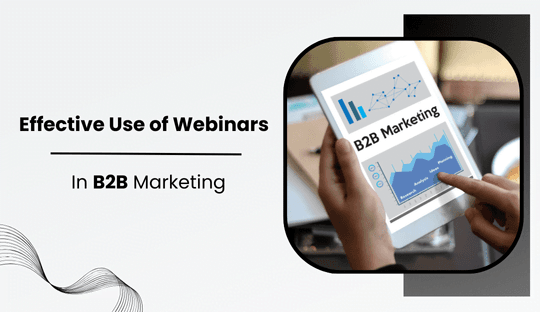
Effective Use of Webinars in B2B Marketing
Webinars have become an essential tool in the arsenal of B2B marketing strategies. They provide a platform for companies to engage with their audience, showcase expertise, and drive lead generation. For creative brand companies like Flykez CO in Slovakia, webinars can significantly enhance digital marketing efforts. This blog post explores the effective use of webinars in B2B marketing, focusing on key strategies to maximize their impact.
The Power of Webinars in B2B Marketing
Webinars offer a unique opportunity to connect with potential clients and industry peers in a more interactive and engaging manner. They can help in building brand authority, nurturing leads, and driving conversions. Here are some reasons why webinars are powerful for B2B marketing:
- Interactive Engagement: Webinars allow for real-time interaction through Q&A sessions, polls, and live chats, providing a dynamic platform for audience engagement.
- Expert Positioning: Hosting webinars on relevant topics showcases your expertise and positions your brand as a thought leader in the industry.
- Lead Generation: Webinars attract attendees who are genuinely interested in your content, making them high-quality leads for follow-up marketing efforts.
Key Strategies for Effective Webinars
1. Choose Relevant Topics
Selecting topics that resonate with your target audience is crucial. Conduct market research to identify pain points, trends, and interests within your industry. Focus on providing valuable insights and actionable takeaways that can address these issues.
Example: If your company offers digital marketing services, a webinar on “Advanced Techniques in Voice Search Optimization” can attract a relevant audience looking to enhance their SEO strategies.

2. Leverage Marketing Automation
Marketing automation tools can streamline the entire webinar process, from promotion to follow-up. Use automation to send personalized invitations, reminders, and post-webinar follow-ups. This ensures a seamless experience for attendees and helps in nurturing leads effectively.
Tools: Platforms like HubSpot and Marketo offer comprehensive marketing automation features that can be integrated with webinar tools.
3. Promote Effectively
Effective promotion is key to attracting a large and relevant audience. Utilize various channels such as email marketing, social media, and your website to spread the word. Collaborate with industry influencers and partners to extend your reach.
Focus Keyword: Digital Marketing, Email Marketing Trends
4. Incorporate User-Generated Content
Encourage attendees to participate actively during the webinar. Use their questions, feedback, and comments to create post-webinar content such as blog posts, social media updates, and follow-up emails. This not only extends the life of your webinar content but also enhances engagement.
Example: Compile a blog post summarizing the key questions and answers from the webinar, showcasing the expertise of your speakers and addressing the audience’s interests. Also Read About 5 Powerful Ways Social Proof Impacts Consumer Decisions
5. Provide High-Quality Content
Ensure that your webinar content is well-researched, informative, and professionally presented. Use engaging visuals, case studies, and real-world examples to illustrate your points. High-quality content keeps the audience engaged and enhances your brand’s credibility.
Example: Use slides, infographics, and video clips to make the presentation more dynamic and engaging.
6. Optimize for SEO
Optimize your webinar landing pages and promotional content for search engines. Use relevant keywords to improve visibility and attract organic traffic. Post-webinar, make the recorded session available on your website and YouTube channel with optimized titles, descriptions, and tags.
Focus Keyword: Voice Search Optimization, SEO

7. Follow-Up and Nurture Leads
After the webinar, follow up with attendees promptly. Send thank-you emails, provide access to the recorded session, and share additional resources. Use marketing automation to segment leads based on their engagement level and tailor your follow-up communications accordingly.
Focus Keyword: Marketing Automation, Email Marketing Trends
8. Measure and Analyze
Track key metrics such as registration numbers, attendance rates, engagement levels, and conversion rates. Use these insights to evaluate the success of your webinar and identify areas for improvement. Continuous analysis helps in refining your webinar strategy for better results.
Tools: Google Analytics, WebinarJam, Zoom Webinars
Conclusion
Webinars are a powerful tool for B2B marketing, offering numerous benefits such as enhanced engagement, expert positioning, and effective lead generation. By choosing relevant topics, leveraging marketing automation, promoting effectively, incorporating user-generated content, providing high-quality content, optimizing for SEO, following up diligently, and measuring performance, Flykez CO can maximize the impact of webinars in their marketing strategy.
For more information on how Flykez CO can help you optimize your digital marketing strategies, visit Flykez CO.
